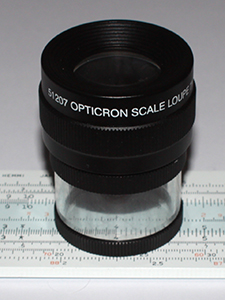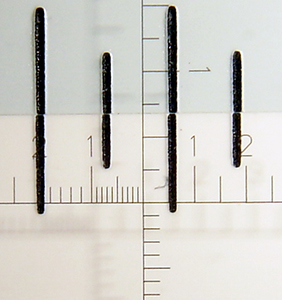|
Some Typical Slide Rules Under the Microscope
David Walker, UK
Note added December 11th 2013. The studies below have been considerably extended since this page was written and have been published as an illustrated article with the same title in the UKSRC 'Slide Rule Gazette', Issue 14, Autumn, 2013, pp. 28-39.
An online version of the Gazette article can be downloaded in Acrobat pdf format here.
The UKSRC is the United Kingdom Slide Rule Circle - their website www.uksrc.org.uk describes membership benefits and resources offered.
|
Aim:
Study a selection of typical slide rule designs and models under a low power microscope (from my very modest collection of 14!) to see if any interesting features are revealed. In particular, do scale features at the microscopic level such as fineness of engraving, quality of inking etc reflect on the subjective visual clarity of the rules?
The comments made are for my own examples and may not be representative.
|
Equipment:
Leica S8 APO 1-8X optical zoom stereo microscope, with 10X eyepieces.
Measurements: A 10 mm reticle graduated to 1 and 0.1mm, laid on each rule and viewed at 20x under stereo to take reading. Values could be read to ca. 0.02 mm. The scale touched the rule and therefore no parallax error in measurements.
Lighting:
1) 144 LED ringlight with intensity control and each quadrant switchable for modelling. (Control box seen on right of image.)
2) 30W halogen light guide for more controlled directional lighting to highlight any subtle surface texture.
Camera: Sony NEX-5N body. White balance preset using custom control. 'Front Curtain Shutter' option set for vibration free imaging.
Slide rules angled at ca. 6░ to lefthand optical axis (the switchable photo port) for optimising field flatness in photos.
|
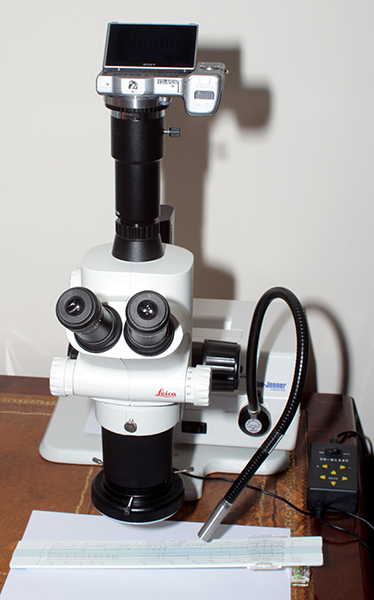
|
Scanner or microscope for studying fine detail?
The CCD design of flatbed scanners have sufficient depth of field to be widely used for excellent imaging of the whole or major parts of slide rules, (cf. the very poor d.o.f. for CIS models, see comparison here of Canon 5600F and LiDE 60). The typical highest scan setting of a consumer flatbed scanner is 1200dpi optical (e.g. the current Canon 5600F), this corresponds to a theoretical resolution of 0.0212
mm (21.2 Ám). This is insufficient for studying fine detail on slide rules and potentially compounded by soft scans if viewed at 1:1 because of the limitations of the scanner optics; the rule design and/or scanner size also often does not permit close contact with the scanner platen. In comparison, the optical resolution of a typical quality stereo microscope as used for the imagery below was at least 7.3 Ám (at 20X) and increasing to 3.3 Ám at its highest optical mag of 80X.
Note on lighting methods
Another benefit of a microscope over a scanner is that modelling of the light is possible for revealing any fine surface texture; the flat lighting of a scanner is not ideal. The typical modern stereo ringlight used with individual lighting quadrants can give some modelling but the lights are still close to the stereo's optical axis. The light guide can give more pronounced off-axis lighting by experimenting with the angle and height of the guide with respect to the rules.
Of the limited rules owned, the Aristo 802 Scholar (new) had the most noticeable raised engravings to the touch. The stereo shows these engravings to have marked peripheral ridges. How different lighting showed these is illustrated below.
|
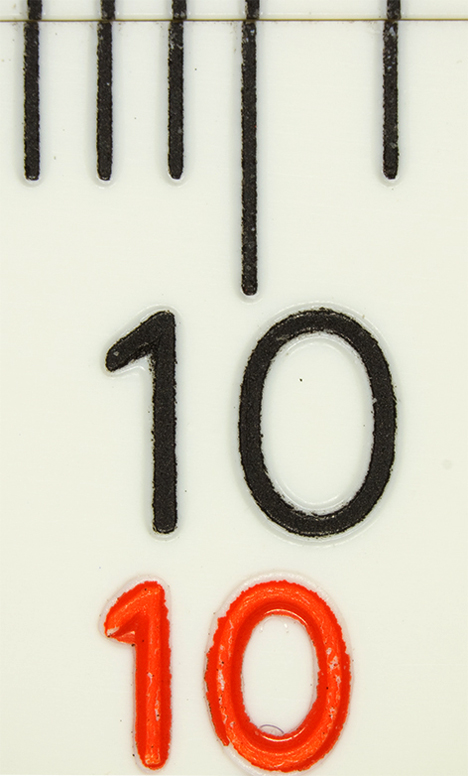
Aristo 802, '10' on A/B scale: LED ring lighting using top and bottom quadrants only. This was the lighting used to measure engraving widths but isn't ideal for modelling any surface detail.
|
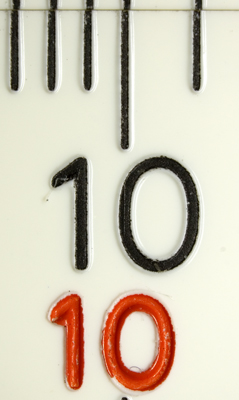
Aristo 802 repeat: LED ring lighting using one quadrant only from the right. This shows the ridges around engravings better.
|
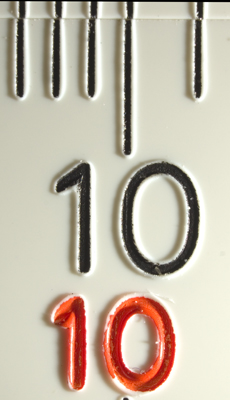
Aristo 802 repeat: Light guide placed to right and just above the rule. This stronger off-axis lighting shows the ridges around engravings best.
|
|
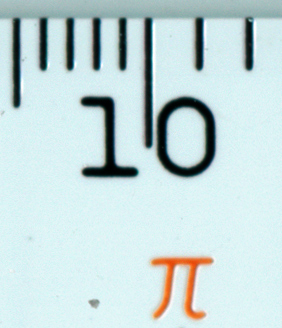
|
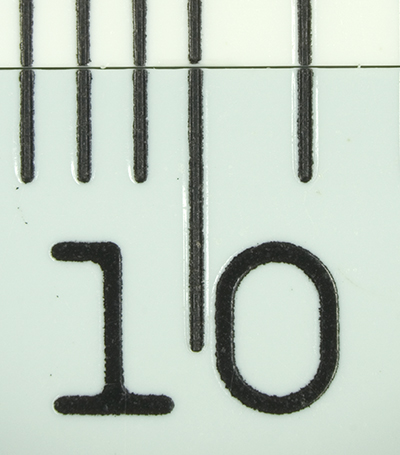 i i
|
Above: Flatbed scanner compared with the Leica S8 microscope, Hemmi P280, detail 'B' scale on slider.
Left: Canon 5600F scanned at its maximum optical 1200 dpi, image crop at 1:1. The image is soft and flat.
Right: Leica S8, optical mag 20X. The Sony NEX-5N at 16 Mpixels oversamples the microscope optics so image crop is resized by a linear factor of 3, but still provides fine details at a modest low mag. For engraving measurements, the 1:1 images were used.
Comparison of engravings, using the '10' mark on C/D scale
Optical mag 20X (images not exactly shown to same scale as engraving marks and spacings to number may differ).
LED ringlight unless stated.
|
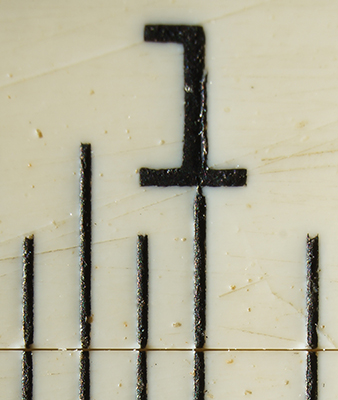
Hemmi 257 'Chemical' rule. Engraved plastic on bamboo.
Low angled lighting with light guide.
|
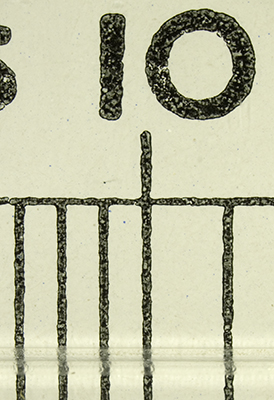
Unique Brighton. Printed scales with clear celluloid strip.
|
|
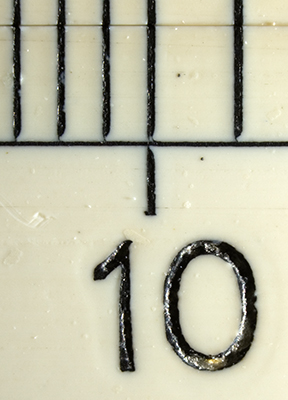
Faber-Castell 1/92, engraved plastic on pearwood.
Low angled lighting with light guide.
|
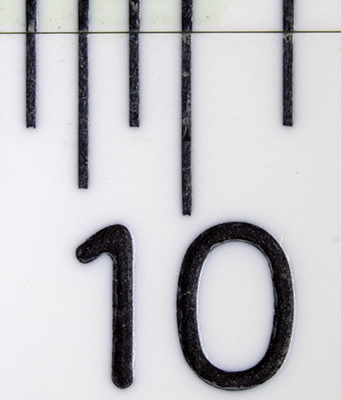
Faber-Castell 2/83N new from Faber 2012. (On D scale.) Engraved plastic. Crisp engraved edges but variable inking and marked pitting, see below.
|
|
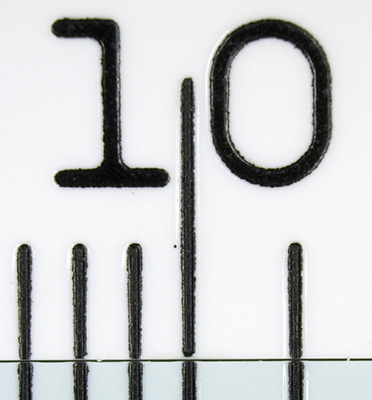
Hemmi P280, engraved plastic. The engravings were densely inked and have rather irregular edges but not obvious visually. The Hemmi had the whitest plastic of my collection.
|
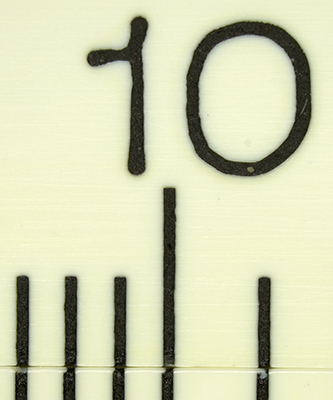
British Thornton AD150 Advanced. Crisp engraving edges and densely inked. The '1' numbering is rather stylised cf other rules owned. Engraved plastic.
|
|
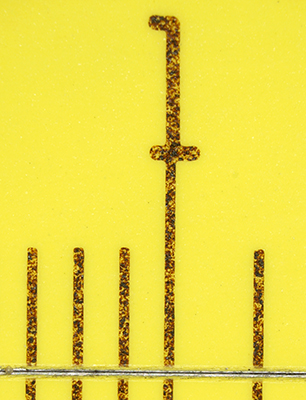
Pickett N902-ES. Ink on painted aluminium. The pale brown mottled inking on the 'Eye Saver' yellow, although crisply figured, does not give to my eye, very contrasty scales / figures cf other rules. See close-up below.
|
|
|
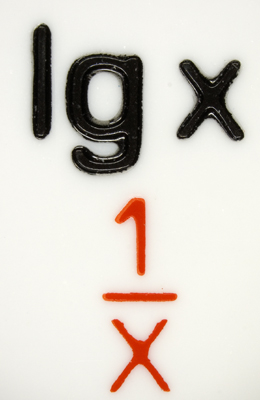
Blundell Harling 802 Log-Log. The engravings and scale marks looked visually somewhat over inked, seen here on two of the scale indexes. It was most marked with the black inking.
|
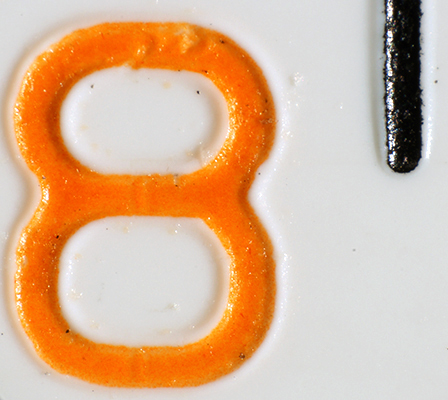
Hemmi P280. This showed a marked rim on the edges of engraved scales and numbers. Shown here on the 'ST' scale with low angled lighting at optical mag of 80X. Also shows the uneven edges to black inking.
|
|
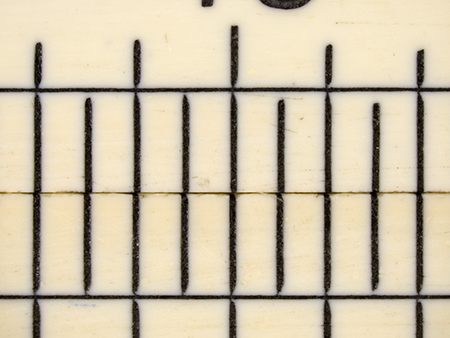
Faber-Castell 1/92. Optical mag 20X. Of the limited slide rules owned with 'railway lines' type scales, this is the only example that features a tapering of the scale bars as they meet the horizontal lines. Was this an intentional feature or just reflects the method of making / inking these engraved marks?
|
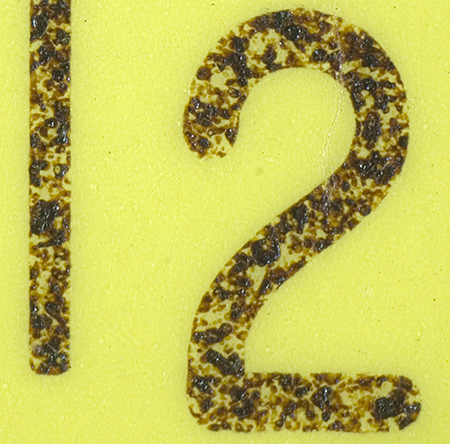
Pickett N902-ES bought 'new in box' from US dealer 2012 (showing part of '20' on the 'S' scale). Optical mag 50X. Showing the inking pattern of both scales and characters. I only own this one example of a Pickett, so uncertain whether either the brown ink and/or the 'mottled' inking are characteristic, either new or after aging.
|
|
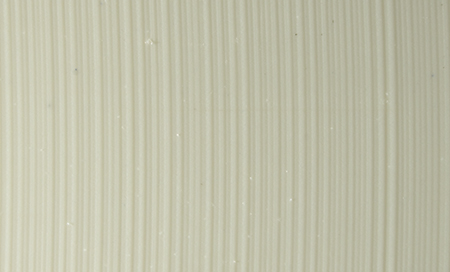
British Thornton AD150 Advanced, underside of slider, image field width 5.4 mm. Optical mag 20X. To the eye there is a hint of surface structure. Under the microscope with low angled side lighting from a light guide, this structure is seen more clearly. Possibly the result of a milling operation on the base?
|
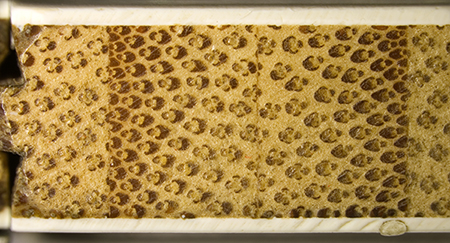
Hemmi 257 'chemical' slide rule: Optical mag 10X. The distinctive patterning of bamboo seen on the end of the slider.
|
|
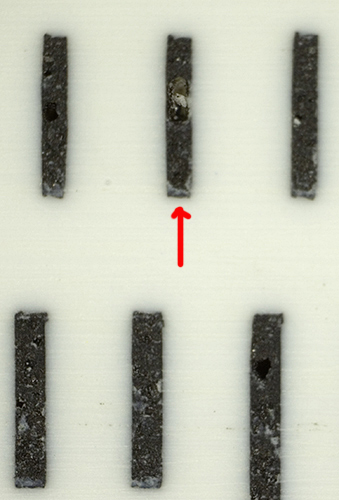
Faber 2/83N. In my example, there is a pitting of the plastic in many of the black (above) and red engraved marks (right above).
There are extensive whitish deposits, some inked, in the engravings, especially along edges. Seen as encroaching material arrowed. Not sure if incursion of the plastic of the stock into marks or deposits from the manufacturing process.
|
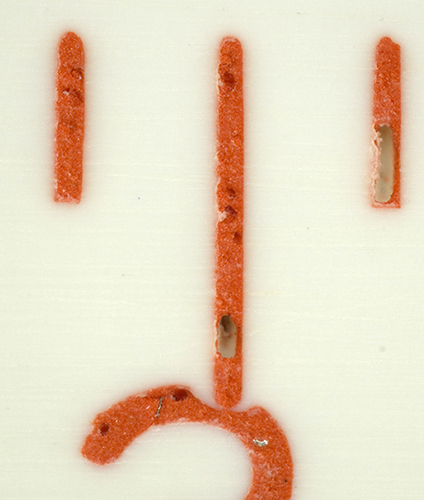
Faber 2/83N. As well as pitting, there is what looks like metal particles embedded in places, seen here in the top of the '3'.
|
The comparisons of measurements below can only be a 'snapshot' of rules and examples owned.
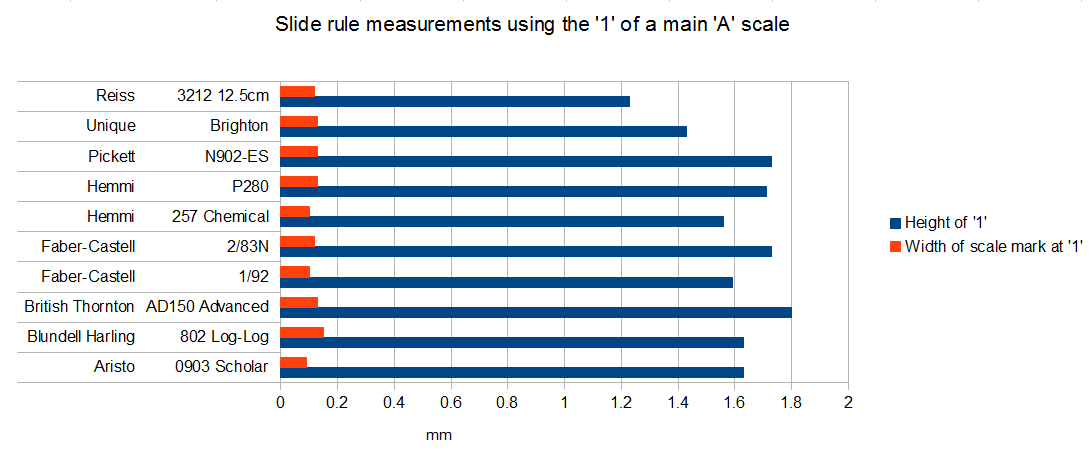
Note: Variations of marking measurements across a rule maybe a factor and not assessed.
Tentative Observations
Of the rules owned, the width of the engraved inked scale markings varied within a range of 0.06 mm; from the narrowest at 0.09 mm (Aristo 0903 Scholar) to the widest at 0.15 mm (Blundell-Harling 802 Log-Log, which looked somewhat over inked). The limited range is perhaps not surprising as overly thin or thick markings may affect a rule's use as well as likely limitations in what is practical to make. The one 12.5 cm rule studied, the Reiss 3212, sat within this range (0.12 mm), suggesting that marking widths are not scaled down for smaller rules, for this example at least.
Number height of engraved main scales for the 25 cm rules varied over a wider range, 0.37 mm, and was noticeable if the two extremes, the Unique Brighton (1.43 mm) and British Thornton AD150 (1.80 mm) were side by side. The number height of the Reiss 3212 12.5 cm rule were lower at 1.23 mm, presumably for clarity
The preferred overall 'look' of a scale is likely very subjective. Putting aside how complex a rule was, factors such as crispness of engraving, how well inked, ink colour, number size and stock / slider colour all likely contribute. How a rule ages could also later affect the original look such as discolouring of the stock / slider, ink deterioration and if any ink bleeding of engravings into surround.
Note on using a calibrated loupe for measuring cf a microscope
As well as measuring the height of numbers and engraving widths by microscopy / imaging, a 7X high quality focussing loupe (Opticron 51207) with graticule sub-divided to 0.1 mm was used. The loupe gave results to within 0.1 mm of the microscopy measurements of number height, but measuring any fine variations of width between 0.1 - 0.2 mm was not possible. The main error was parallax, as scale a little raised above slide.
David Walker





 i
i















